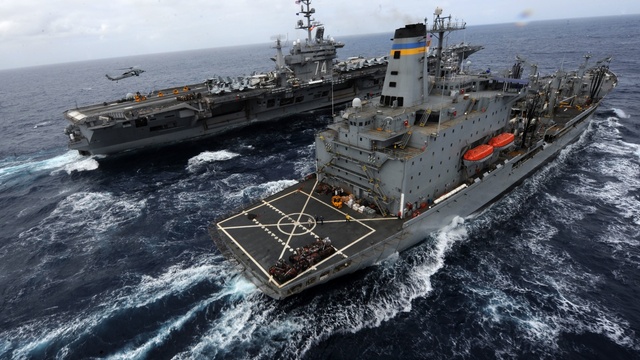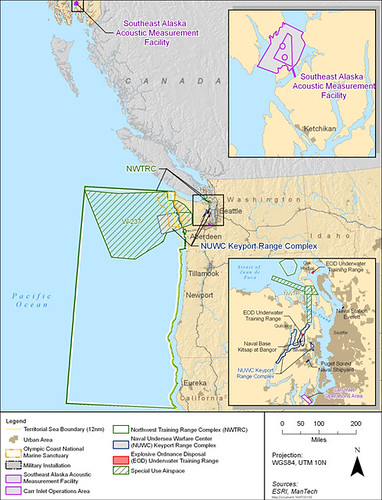
The U.S. Navy’s aircraft carrier USS John C. Stennis transits the Pacific Ocean alongside the oiler USNS Yukon. | credit: Official U.S. Navy Imagery/Specialist 3rd Class Kenneth Abbate
By Ashley Ahearn, KUOW
SEATTLE — The Navy is pursuing permits to continue conducting sonar and explosives exercises in a large area of the Pacific Ocean — and that’s putting marine mammal advocates on high alert.
Public hearings kick off next week as the Navy gathers public comments on its draft environmental impact statement for the Northwest training and testing range. The range stretches from northern California to the Canadian border.
Marine mammals, like porpoises, gray and fin whales and endangered orcas, travel through the Navy’s training range. That’s why marine mammal advocates are voicing concerns about the Navy’s activities.
In the draft EIS the Navy outlined plans to conduct up to 100 mid-range active sonar tests each year. That type of sonar has been shown to affect marine mammal behavior.
The Navy also wants to conduct up to 30 bombing exercises per year in the range.
John Mosher, Northwest Environmental program manager for the U.S. Pacific Fleet, says the training range is critical to naval preparedness.
“At some point realistic training, whether it’s with explosives or sonar, has to take place and they truly are skills that are perishable, things that have to be routinely conducted to be able to do them in case the real need occurs,” Mosher said.
The Navy gathered more than 300 public comments during an earlier scoping phase of its environmental review. Most of those comments centered around impacts on marine mammals.
The Navy has plans in place to look and listen for marine mammals before and during testing exercises. But environmentalists say the mitigation measures are inadequate.
“They’re dropping bombs and you can’t see orcas from the air,” said Howard Garrett of Orca Network. “There’s every real danger that orcas are going to stray into a live bombing range and we don’t want to see that.”
The National Oceanic and Atmospheric Administration has been studying the endangered orca population of Puget Sound by tagging orcas and using underwater acoustic monitoring devices to better understand how the whales move through the region. The population of Southern Resident Orcas is hovering around 80 individuals, and has been decreasing in recent years.
Brad Hanson, an expert on orcas with NOAA, says the area within the naval training and testing range is an important forage area for the whales.
“We want to figure out if there are particular areas that the whales are using so the Navy could avoid using those areas for training exercises that might cause any type of harassment of the animals,” he said.
Hanson’s tagging research has shown orcas moving from Washington to northern California within the span of a week.
Last year a 3-year-old female orca washed up dead near the mouth of the Columbia River. Her body showed signs of trauma that could have been the result of an explosion but it had been drifting on the Columbia River’s eddies for days, making the results of the necropsy report inconclusive. The official findings were to be released by NOAA Fisheries on Monday.
“It’s probably the most comprehensive necropsy report I’ve ever seen done on a killer whale,” Hanson said.
The Navy also recently announced plans to build a new $15 million dollar facility near Port Angeles, Wash. on the Strait of Juan de Fuca.
What’s Next
Public meetings will be held from 5-8 p.m. for the following dates and locations:
- Feb. 26, 5-8 pm: Oak Harbor High School, Oak Harbor, Wash.
- Feb. 27, Cascade High School, Everett, Wash.
- Feb. 28, North Kitsap High School, Poulsbo, Wash.
- March 3, Astoria High School, Astoria, Ore.
- March 4, Isaac Newton Magnet School, Newport, Ore.
The deadline for written comments on the Northwest Training and Testing range EIS is March 25.



